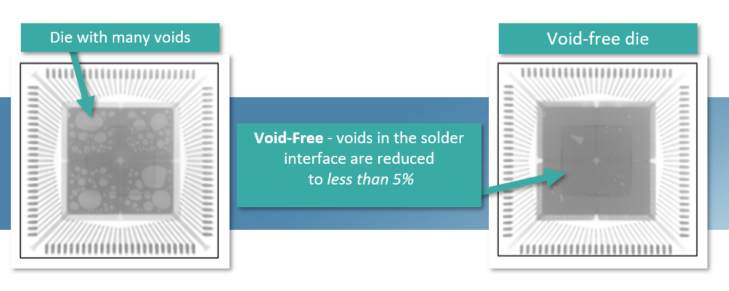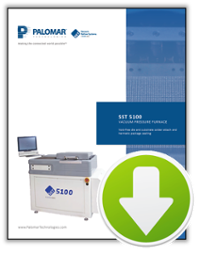Using the correct system, tooling, process, and making wise material choices while considering material preparation are all factors and important points that need to be considered when looking to achieve void-free die attach.
 Vacuum reflow systems is one solution that can provide the perfect controlled environment to start and by utilizing optimum tooling design and tight process parameters that control vacuum, heat, forming gases, formic acid and most important of all, overpressure. It’s a combination of all these factors working together to achieve the very best void free results.
Vacuum reflow systems is one solution that can provide the perfect controlled environment to start and by utilizing optimum tooling design and tight process parameters that control vacuum, heat, forming gases, formic acid and most important of all, overpressure. It’s a combination of all these factors working together to achieve the very best void free results.
The devices to be assembled are located within custom design tooling and placed within a vacuum reflow chamber. Once the chamber is sealed the profile is commenced. This profile consists of multiple stages, typically including vacuum, pressure, pre-heat and reflow temperature along with cool down.
Essentially the aim is to remove air, particulates and moisture to create as inert an atmosphere as possible. Nitrogen purging is typically done to assist this process. The reflow chamber contains the heating elements that should be either graphite resistive heating elements to create a radiant heat and edge heating elements, also of graphite, to create a very stable and uniform temperature within the chamber. Inserted into the chamber is a graphite target plate. This is where the completed tooling assembly is placed.
Custom tooling is absolutely key to the success in achieving virtually void-free die attach using a vacuum reflow system. The purpose of the device tooling is to fix or stabilize the position of the components to be assembled. This may of course be for various potential reasons. One may be to ensure alignment and positional accuracy.
Considerations for Successful Void-Free Attach
Selecting the correct solder can determine the success of the application. Before any other aspects of the solder can be determined, temperature limitations of the application must be specified. The melting point of the solder must fall within the limitations of the device components maximum temperature along with any other solders used.
Solder preforms are absolutely crucial to achieving void free soldering. Preforms can be cut to specific sizes and shapes, depending on the application. Solder preforms do not contain any organics or other compounds that can hinder the die attach soldering process.
.png?width=631&name=Systems%2c%20Tools%2c%20and%20Processes%20for%20Void-Free%20Die%20Attach%20(2).png) Commonly used solder preforms.
Commonly used solder preforms.
Lastly, flux should be avoided when selecting solder for a die attach application because flux can cause process issues and also mechanical equipment issues with flux getting caught in gas lines.
When executing a successful void-free soldering application, tight temperature control is extremely important. Large temperature fluctuations during the reflow stage of a soldering process can contribute to insufficient solder wetting, solder splatter, and overall increase in voiding.
Tooling Considerations – Graphite is the Best
Tooling or fixtures hold solder and dies in place when conducting die attach soldering. Graphite tooling offers characteristics that other materials cannot e.g. low thermal expansion. Thermal expansion goes hand in hand in soldering applications. Typically, different materials are being soldered together and naturally, there will be competing thermal expansion coefficients; this is why graphite is a good option with its low expansion rate.
.jpg?width=450&name=Systems%2c%20Tools%2c%20and%20Processes%20for%20Void-Free%20Die%20Attach%20(3).jpg) Example of graphite tooling, weights and inserts.
Example of graphite tooling, weights and inserts.
Additionally, graphite can withstand most, if not all, die attach soldering applications. It is not degraded through thermal cycling as long as it is used in an inert environment. Benefits of graphite:
- Excellent thermal conductivity and low thermal expansion
- Withstands high temperature (up to 2000C) while increasing strength
- Great for high current densities and aggressive ramp up times
- Low vapor pressure and is not degraded by thermal cycling
- Lightweight and easily machined
Conclusion:
There are many factors to consider when it comes to achieving successful die attach; one of the most important of these factors is solder interface voiding. Voids in the solder interface contribute to various failure modes including overheating via non-uniform dissipation of heat and high mechanical stresses. Using the proper material, solder and process/tooling is critical to achieving low-void.
Vacuum reflow systems offer solutions to achieve low solder interface voiding through chamber pressure manipulations and surface treatment options. In addition, the correct solder material selection is key in achieving excellent bond quality. Each application is unique and requires careful consideration when it comes to solder material selection.
Download these resources for more information:

